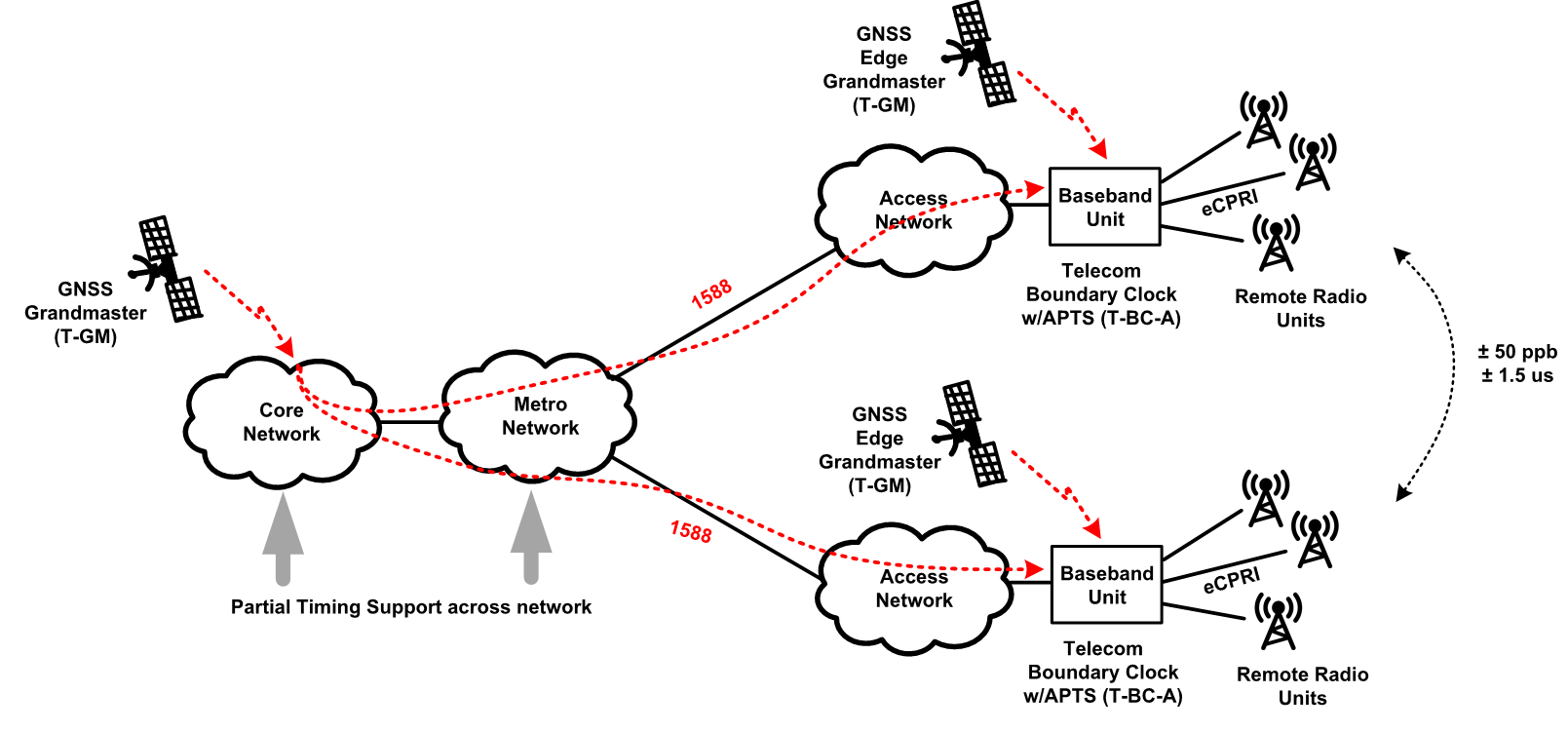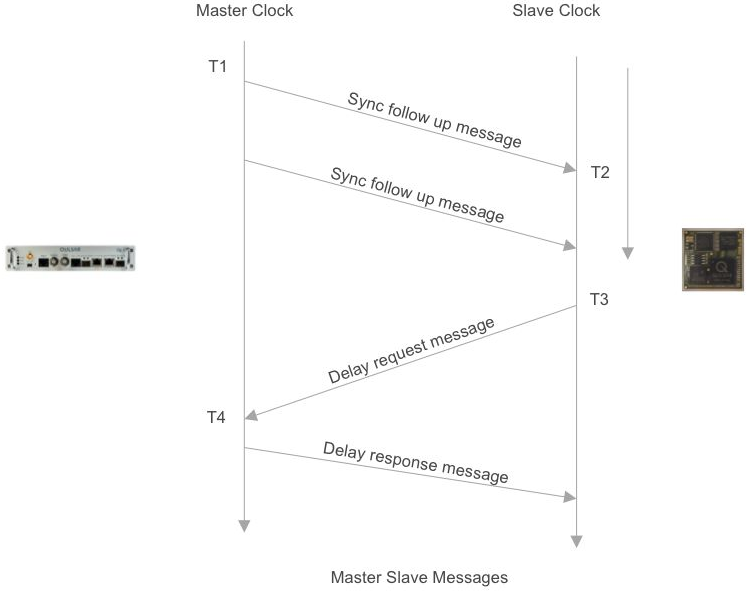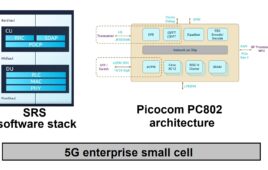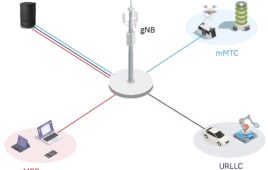GPS and GNSS have been the standards for network timing, but they have security issues. A Master clock and IEEE 1588 reduces the risk and lowers installation costs.
Global Navigation Satellite Systems (GNSS) provide the critical primary reference clocks that networks need to correctly operate and seamlessly coordinate the flow of voice, data and video traffic. Networks synchronize to these clocks, which are then distributed across the network. While GNSS can provide reliable and accurate timing, they have issues, especially when applied to 5G mmWave installations.
Each GNSS satellite contains multiple, highly accurate atomic clocks that contribute precise time data to GNSS signals. GNSS receivers decode these signals from multiple satellites, synchronizing each receiver to the atomic clocks in the satellites. In this manner, a GNSS receiver can pinpoint time to better than 10-9 seconds without requiring an expensive, local atomic clock. In addition to communication networks, GNSS timing provides precise operation for power grids, stock exchanges, data centers, public safety networks, maritime transportation and the aviation industry. There are multiple GNSS networks worldwide including the United States’ GPS satellite network, the Beidou Navigation Satellite System operating in China, the Galileo in the EU and the Global Navigation Satellite System (GLONASS) operating in Russia.
There are, however, multiple growing cybersecurity risks and technical challenges associated with GNSS. First, a GNSS signal can easily be jammed. For less than $100, a hacker can purchase a GPS jammer that interferes with or mimics a GNSS signal (Figure 1). As a case in point, in 2019 several aircraft flying near the Ben Gurion airport in Tel Aviv reported disruption to their satellite navigation systems, preventing them from landing and taking off until the threat was isolated. While such deliberate jamming events can make the headlines, accidental jamming, for example from faulty equipment radiating unintentional signals, can also occur with the same impact on GNSS availability.
Another cybersecurity threat associated with GNSS is spoofing, which uses a radio transmitter near the target to send out fake GNSS information, interfering with its operation. GNSS signals have relatively low signal strength, making them vulnerable to this intentional interference. In 2019, dozens of ships navigating the Black Sea reported receiving false location data reporting the ships were as much as 25-30 miles from their true location. Any device in the area using GNSS for timing would have been off by more than 100 microseconds – a massive error for a telecommunications network. This spoofing attack was later attributed to the Russian military hacking, disrupting global navigation systems.
GNSS technology also poses multiple technical and practical challenges. GNSS requires synchronization to four or more satellites to accurately pinpoint each receiver’s location and recover precise time, a process referred to as trilateration. In major metropolitan centers such as New York City, the skyline is dotted with skyscrapers and other buildings that can potentially block wireless signals. In dense urban environments, and even more so indoors, it is not always possible to establish a direct line-of-sight connection with enough GNSS satellites. This becomes an increasing problem with the shift from using widely spread macro base stations in well-engineered locations to using dense small cells in 5G deployments. In addition, the cost of installing and operating GNSS equipment can be prohibitive for some applications.
Network synchronization requirements are becoming more stringent as the wireless communications industry shifts from 4G to 5G. Most 4G Radio Access Networks (RAN) rely on frequency-division duplex (FDD) technology, which require base stations to be frequency synchronized to within ±50 ppb. 5G is based on more cost and spectrum-efficient time-division duplex (TDD) technology, which requires time (frequency and phase) synchronization of base stations to within ±1.5 µsec absolute time error. New applications such as Coordinated Multi-Point (CoMP), which minimizes interference between cell sites, and location positioning for emergency services require even tighter time synchronization to <=1 µsec relative time error. The virtualization and centralization of 5G functions driven by cost reduction push the requirements even further, to under 100 ns in some applications.
The cost of installing GNSS at all 5G RAN sites is not practical. Due to the increasing number of cybersecurity vulnerabilities associated with GNSS, 5G RAN and transport networks are being purpose-built to reduce their reliance on GPS/GNSS. Rather than deploying GNSS everywhere, these networks will increasingly use IEEE 1588 packet-based network synchronization. IEEE 1588-2008, or Precision Time Protocol (PTP), is a packet-based, two-way message exchange protocol used to share precise timing information across an Ethernet network.
A primary benefit of PTP is security. Data can be encrypted, and critical timing and synchronization data can be carried across the network, greatly reducing the cybersecurity risks associated with GNSS jamming and spoofing. IEEE 1588 doesn’t completely replace GNSS – it can’t source time, only transport it (Figure 2). It does, however, let one GNSS receiver provide time to multiple devices, reducing cost and deployment challenges. By including multiple, geographically remote GNSS receivers, IEEE 1588 also mitigates the effects of jamming and spoofing.
Networking equipment can use IEEE 1588 to synchronize a local clock with a primary reference clock by internally adjusting its clock to compensate for internal delay. Multiple network elements can then be connected using IEEE 1588 to a common primary reference clock using common network topologies such as hub-and-spoke or mesh networks. The overall time error across the network increases as a function of the number of network elements increase. In addition, packet delay variation due to network asymmetry and variable traffic load conditions further contribute time error, limiting the number of nodes that can be practically connected to each other over PTP without exceeding the network time error budget. Careful networking planning and leveraging high-performance timing solutions can help mitigate these constraints.
5G is an overlay network that is being deployed to work in conjunction with existing legacy networks. This means that in most initial 5G network deployments, some new elements within the network will support IEEE 1588 while legacy equipment may not. IEEE 1588 standards accommodate this common use case, which is referred to as Partial Timing Support (PTS), by enabling PTP traffic to be carried across a mix of IEEE 1588-aware and non-aware network elements.
Increasingly, wireless carriers now view GNSS and IEEE 1588 as complementary technologies. GNSS can be used to provide tight time accuracy among base stations. IEEE 1588 can provide cost-efficient network synchronization while reducing GNSS vulnerabilities.
Many 5G networks will deploy a mix of GNSS and IEEE 1588 technologies, leveraging a recently ratified IEEE 1588 standard referred to as Assisted Partial Timing Support (APTS). Figure 3 shows an example of an APTS network in which carriers place an Edge Grandmaster GNSS at the edge of the Radio Access Network. GNSS provides the primary reference clock for remote radio units, ensuring high accuracy and tight coordination between the RAN’s cell sites.

Figure 3. IEEE 1588 transfers timing from a Grandmaster clock throughout a packet-based network. (Click image to enlarge)
 James Wilson serves as the General Manager of Silicon Labs’ timing products, managing the company’s overall timing business and directing product strategy, roadmap development, new product initiatives, product management, software development and marketing initiatives. Prior to joining Silicon Labs in 2002, Mr. Wilson held a variety of marketing, product management and engineering roles at Freescale Semiconductor (now NXP) and various start-ups. Mr. Wilson holds a Bachelor of Science degree in mechanical engineering and a master’s degree in business administration from The University of Texas at Austin.
James Wilson serves as the General Manager of Silicon Labs’ timing products, managing the company’s overall timing business and directing product strategy, roadmap development, new product initiatives, product management, software development and marketing initiatives. Prior to joining Silicon Labs in 2002, Mr. Wilson held a variety of marketing, product management and engineering roles at Freescale Semiconductor (now NXP) and various start-ups. Mr. Wilson holds a Bachelor of Science degree in mechanical engineering and a master’s degree in business administration from The University of Texas at Austin.






Great article
Explained the needs of 1588 for 5G application very well!
Great explanation and 5G security details.